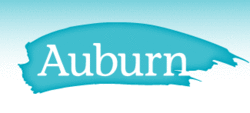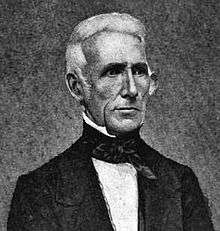Auburn Theological Seminary
 | |
| Type | 501(c)(3) charitable organization |
|---|---|
| Focus | Religious education and activism |
| Location | |
| Method | Education, advocacy |
Key people |
Rev. Dr. Katharine Henderson (President) Rev. John Vaughn (Executive Vice President) Macky Alston (V.P., Auburn Media) Rabbi Justus Baird](Dean) Isaac Luria (V.P., Auburn Action) Valarie KaurFounding Director, Groundswell |
| Endowment | $20.4 million (2016)[1] |
| Website |
www.auburnseminary.org www.groundswell-movement.org |
Auburn Theological Seminary, located in New York City, trains leaders who are working on progressive social issues. It offers workshops, provides consulting, and conducts research on faith leadership development.
The seminary was established in Auburn, NY, in 1818 to prepare young ministers for the frontier. Weakened by the Great Depression, Auburn relocated in 1939 to Union Theological Seminary's campus in New York City, although it maintained its independence from Union. In 2014, it designed and moved to a new leadership development lab in the Interchurch Center in Morningside Heights. Auburn houses the only research center in the U.S. focused on the study of seminaries, divinity schools, and the preparation of faith leaders working for social justice. Auburn was one of the first seminaries in the country to admit African Americans (Moses Hopkins, 1877), Japanese (Naomi Tamura, 1882) and later, female seminarians (Ida Thorne Parker, 1917). [2]

History
Auburn Seminary was established in Auburn (Cayuga County) by action of the Presbyterian Synod of Geneva on 16 August 1818.[3] It obtained a charter from the New York State legislature on 14 April 1820 [4] as a post-baccalaureate theological seminary and matriculated its first students in 1821.[5] From its inception, Auburn Seminary drew support from beyond the Presbyterian Church. Its charter stipulated that "no student of any Christian denomination shall be excluded,[6]" and the first class of eleven students represented eight denominations.[7] The Roman Catholic bishop from Boston, Bishop Chevereux, donated books for the school's library.[8]
The school's founders and early faculty (Dirck Lansing, Matthew Perrine, and Henry Mills) rejected sterner forms of Calvinism and advocated for flexible church governance within the Presbyterian Church. These beliefs became known as the Auburn Declaration of 1937.[9]
Under the presidency of George Black Stewart (1899-1926), the school grew to 105 students and eleven faculty. A Summer School of Theology for clergy and laity was established in 1911,[10] and a School of Religious Education in 1921.
Auburn faculty (led by Robert Hastings Nichols, professor of church history) played a key role in what became known as the Auburn Affirmation (adopted in 1924) which defended theological freedom and prevented a fundamentalist takeover of the Presbyterian Church.[11]
The Great Depression left Auburn Seminary with a diminished student body and strained resources. The faculty and President Rev. Paul Silas Heath (1936-1939) began conversations with several seminaries about possibly relocating. In 1939, it closed its Auburn campus and at the invitation of President Henry Sloan Coffin, moved to the campus of Union Seminary in New York City, although it maintained its board of trustees and endowment.[12]
With the move to Union, Auburn Seminary ceased granting degrees, instead developing new initiatives: a Program of Training for Rural Ministry in 1944, which continued its emphasis on preparing individuals for the practice of ministry, not for theological specialization; in 1964 the Center for Continuing Education was established as well as the Experimental Program for the Practice of Christian Ministry; in 1968 Auburn Studies in Theological Education was begun; in 1971 the Susquehanna Valley Project to support local ministers started;[13] in 1985 interreligious programs for faith leaders were developed and in 1991 The Center for the Study of Theological Education was established.
In 2009, the Rev. Dr. Katharine Rhodes Henderson was inaugurated as president, shifting the institution’s focus toward training and supporting faith leaders who work in progressive justice organizations and movements. Auburn's signature programs include: media training, Auburn Senior Fellows, Sojourner Truth Leadership Circle, digital organizing, coaching for faith leaders, and entrepreneurial ministry. Auburn Research explores the needs of theological institutions, their leaders and students, and the ways in which leaders of faith and moral courage are affecting positive social change in society.
Presidents of Auburn Theological Seminary*
- Rev. Henry Matthias Booth, D.D. LLD. (1893-1899)
- Rev. George Black Stewart, D.D., S.T.D, LLD. (1899-1926)
- Rev. Harry Lathrop Reed, D.D. S.T.D. (1926-1936)
- Rev. Paul Silas Heath, D.D. (1936-1939)
- Rev. Walter S. Davison, Executive Director (1939-1944)
- Rev. Henry Sloan Coffin, Union and Auburn Seminary president (1944-1945)
- Rev. Henry P. Van Dusen, Union and Auburn Seminary president (1945-1964)
- Rev. Robert Lynn, Dean ( -1976
- Barbara G. Wheeler, President (1980-2009)
- Rev. Henry Matthias Booth, D.D. LLD. (1893-1899)
- Rev. George Black Stewart, D.D., S.T.D, LLD. (1899-1926)
- Rev. Harry Lathrop Reed, D.D. S.T.D. (1926-1936)
- Rev. Paul Silas Heath, D.D. (1936-1939)
- Rev. Walter S. Davison, Executive Director (1939-1944)
- Rev. Henry Sloan Coffin, Union and Auburn Seminary president (1944-1945)
- Rev. Henry P. Van Dusen, Union and Auburn Seminary president (1945-1964)
- Rev. Robert Lynn, Dean ( -1976)
- Barbara G. Wheeler, President (1980-2009)
- Rev. Katharine Rhodes Henderson (2009-present )
- Prior to 1893, the seminary was directed by faculty and the board and between 1944 and 1964, Auburn Seminary shared the presidency with Union Seminary.
Notable alumni
- Maltbie Davenport Babcock (1858–1901)
- Dwight Baldwin (1798–1886)
- David Riddle Breed (1848–1931)
- Henry Roe Cloud (1884–1950)
- Titus Coan (1801–1881)
- Sheldon Dibble (1809–1845)
- Justus Doolittle (1824–1880)
- Josiah Bushnell Grinnell (1821–1891)
- Charles Frederic Goss (1852-1930)
- Laurentine Hamilton (1826–1882)
- Joel T. Headley (1813–1897)
- Moses A. Hopkins (1846–1886)
- Herrick Johnson (1832–1913)
- George Williams Knox (1853–1912)
- Lorenzo Lyons (1807–1886)
- Edward Payson Roe (1838–1888)
- Boon Tuan Boon-Itt (1865–1903) an early leader in the Protestant Christian community of Thailand
Notable faculty
- John Colman Bennett
- Timothy Grenville Darling
- James A. Forbes (born 1935)
- Laurens Perseus Hickok (1798–1888)
- Josiah Hopkins
- Matthew LaRue Perrine
- William Greenough Thayer Shedd (1820–1894)
- George Black Stewart
- Walter Wink
- Parker Palmer (1984....)
- James Richards (1767-1843)
Religious Leaders associated with Auburn Seminary
- Rev. Dr. William Barber II, pastor of Greenleaf Christian Church in Goldsboro, North Carolina and founder in 2013 of the Moral Monday.
- Rabbi Sharon Brous, founding rabbi of IKAR, a Jewish movement in Los Angeles.
- Sister Simone Campbell, executive director of NETWORK, the Catholic social justice lobby known as the "Nuns on the Bus"
- Bishop Minerva G. Carcano, United Methodist Church and a leader for immigration reform in the U.S.
- Rev. Dr. Noel Castellanos, president of the Christian Community Development Association,
- Bishop Yvette Flunder, founder of the City of Refuge United Church of Christ (Oakland, CA) and presider of The Fellowship of Affirming Ministries.
- Lisa Sharon Harper, Chief Church Engagement Officer for Sojourners and trainer, founding director of New York Faith and Justice
- James Forbes, senior minister emeritus of Riverside Church in New York City
- Rev. Dr. Peter Hetzel, director of the Micah Institute, associate professor of Systematic Theology, New York Theological Seminary
- Valarie Kaur, interfaith leader, civil rights lawyer and filmmaker.
- Rabbi Stephanie Kolin, associate rabbi of Central Synagogue in New York City.
- Rev. Dr. Jacqui Lewis, senior minister of Middle Collegiate Church in New York City
- Rev. Michael-Ray Mathews, ordained American Baptist minister, director of clergy organizing for PICO National Network
- Brian D. McLaren, national speaker and activist and author of Why did Jesus, Moses, the Buddha and Mohammed Cross the Road?
- Rev. Dr. Otis Moss III, senior pastor of Trinity United Church of Christ in Chicago
- Bishop Gene Robinson, first openly gay man to be elected bishop in the Episcopal Church
- Peter Rubenstein, rabbi emeritus of Central Synagogue in New York City
- Linda Sarsour, co-founder of the first Muslim online organizing platform, MPower Change
- Rev. Dr. Raphael Warnock, senior pastor of Ebenezer Baptist Church in Atlanta
- Rev. angel Kyodo Williams Sensei, found of the Center for Transformative Change in Berkeley
References
- ↑ "U.S. and Canadian Institutions Listed by Fiscal Year 2016 Endowment Market Value and Change* in Endowment Market Value from FY2015 to FY2016" (PDF). NACUBO. February 2017. Retrieved 23 March 2017.
- ↑ Edward Rossman, Kathleen Walker and Marcia Walsh. A History of Willard Memorial Chapel and the Auburn Theological Seminary (Community Preservation Committee, 2013)
- ↑ Minutes of the Synod of Geneva, An Act to incorporate the Presbyterian Theological Seminary, established by the Synod of Geneva, at Auburn, in the County of Cayuga. Vol. 1:111, 130, 1820
- ↑ 43rd Session of the Assembly of the State of New York, 1820
- ↑ John Quincy Adams. A History of Auburn Theological Seminary, 1818-1918 (Auburn Seminary Press, 1918) pg. 55
- ↑ 43rd Session of the Assembly of the State of New York, 1820
- ↑ Minutes of the Faculty, April 4, 1822
- ↑ Adams, pg. 100
- ↑ Minutes of the General Assembly, Old School, 1868, pg. 663
- ↑ Adams, pg. 172
- ↑ Charles Evans Quirk, “Origins of the Auburn Affirmation,” Journal of Presbyterian History. 53.2 (Summer 1975)
- ↑ V. Clifford, Board of Directors’ Report, Auburn Seminary: A recent history. March 17, 1978
- ↑ Ibid.
Coordinates: 40°48′39″N 73°57′50″W / 40.81081°N 73.96398°W